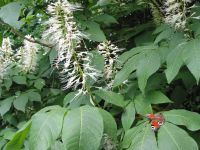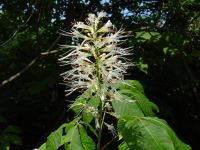Bottle-brush Buckeye - Aesculus parviflora
English name:
Bottle-brush Buckeye
Scientific name:
Aesculus parviflora
Family:
Hyppocastanaceae (Horsechestnut family)
Height:
up to 4 m. in Denmark
Flowering:
Late July early August
Range:
Southeast U.S.A.: Georgia, Alabama, Florida
 |
|
 |
 |
The approximately 65-year-old Aesculus parviflora in the picture can be found by the Lake road and a few meters from the large Henrys popular tree of the Arboretum, in square 1210 position 335.
Plant description:
The genus Aesculus is reported to contain about 13 species. The genus is normally placed in the Hippocastanaceae family but some evidence indicates it should be put into the family Sapindaceae. The genus has a scattered natural range in the S.E. Europe, India and East Asia and in North America. The trees are widely cultivated and the common horse chestnut, Aesculus hippocastanum, has become naturalized in much of Europe including Denmark. The fruit of horsechestnuts are poisonous and have been used to poison and capture fish. The Arboretums collection contains 10 differently named species and 4 hybrids. We have 4 specimens of Aesculus parviflora, but we have no wild collected specimens. The origin of most of our plants is unknown but they probably come from the Hesse Nursery, Weener Am Ems, Ostfriesland, Germany.
Aesculus parviflora grows well and flowers abundantly both in the sun and under medium shade in our Arboretum. It appears to have no health problems. It is not common in Denmark, but deserves to be used more widely as a late flowering, bush. The bushes are covered with white attractive flowers after the main blooming season has finished for most other plants. They are very attractive to bees and butterflies (see photograph). The leaves are yellow to yellow-green in the autumn. Seed production is rare in Denmark because the summers are too short and cool. The plant suckers from the base but it is not aggressive. Plants can be regenerated by taking root cuttings in late autumn or early winter or digging up suckers. Plants can be rejuvenated by cutting back to about 10 cm above the ground. The only drawbacks are the plant is reported to be deadly poisonous if eaten and its suckering is more aggressive in some climates.
The compound leaves are opposite, palm shaped and typically with 5 leaflets (sometimes 7). The white flowers occur in cylindrical panicles (usually upright) held above the foliage (although hanging in one variety). The stamens project well out from the flower petals, are showy and terminated by striking, red, anthers. The nut-like seed capsules are pear shaped and smooth without hairs.
References:
References: Poor, J.M. & Brewster, N.P. 1996. Plants that Merit Attention. Shrubs. Timber Press Publisher pp. 30-33.
Mabberley, D.J. 1997. The Plant Book. Cambridge University Press, Cambridge, UK. Pp 14-15.
Bean, W.J. 1976 Trees and Shrubs Hardy in the British Isles Vol 1. A-C. Bean and Murray publishers. Pp 261.
http://www.hort.net/profile/hip/aespa/ Mallorn Plant of the Month
Plants for a Future: https://pfaf.org/user/Default.aspx
